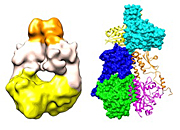Home > Press > Scientists decipher structure of nature’s ‘light switch’
 |
| Left: 3-D phytochrome map; Right: Fit-together fragments forming two sister units (one shown as ribbon, the other in space-filling format), revealing twisted structure. |
Abstract:
When the first warm rays of springtime sunshine trigger a burst of new plant growth, it's almost as if someone flicked a switch to turn on the greenery and unleash a floral profusion of color.
Scientists decipher structure of nature’s ‘light switch’
Posted on June 23rd, 2010Opening a window into this process, scientists at DOE's Brookhaven Lab and collaborators at the University of Wisconsin have deciphered the structure of a molecular "switch" known as a phytochrome that is much like the one plants use to sense light. They used a combination of electron microscopy, cryo-electron microscopy, and computational techniques to produce a 3-D map of the full structure. They then used this map to piece together the detailed structures of small phytochrome fragments that had been previously determined using x-ray crystallography.
The new structure revealed a long twisted area of contact between two individual "sister" units, with a good deal of flexibility at the untwisted ends. This structure supports the idea that the absorption of light somehow adjusts the strength or orientation of the contact, and through a series of conformation changes, transmits a signal down the length of the molecular interface. Understanding how these changes in shape send signals that help plants know when to flower, produce chlorophyll, and grow may help scientists design new ways to modify plant growth.
####
For more information, please click here
Contacts:
Karen McNulty Walsh
631.344.8350
Copyright © DOE Pulse
If you have a comment, please Contact us.Issuers of news releases, not 7th Wave, Inc. or Nanotechnology Now, are solely responsible for the accuracy of the content.
| Related News Press |
News and information
![]() Researchers develop molecular qubits that communicate at telecom frequencies October 3rd, 2025
Researchers develop molecular qubits that communicate at telecom frequencies October 3rd, 2025
![]() Next-generation quantum communication October 3rd, 2025
Next-generation quantum communication October 3rd, 2025
![]() "Nanoreactor" cage uses visible light for catalytic and ultra-selective cross-cycloadditions October 3rd, 2025
"Nanoreactor" cage uses visible light for catalytic and ultra-selective cross-cycloadditions October 3rd, 2025
Possible Futures
![]() Spinel-type sulfide semiconductors to operate the next-generation LEDs and solar cells For solar-cell absorbers and green-LED source October 3rd, 2025
Spinel-type sulfide semiconductors to operate the next-generation LEDs and solar cells For solar-cell absorbers and green-LED source October 3rd, 2025
Academic/Education
![]() Rice University launches Rice Synthetic Biology Institute to improve lives January 12th, 2024
Rice University launches Rice Synthetic Biology Institute to improve lives January 12th, 2024
![]() Multi-institution, $4.6 million NSF grant to fund nanotechnology training September 9th, 2022
Multi-institution, $4.6 million NSF grant to fund nanotechnology training September 9th, 2022
Announcements
![]() Rice membrane extracts lithium from brines with greater speed, less waste October 3rd, 2025
Rice membrane extracts lithium from brines with greater speed, less waste October 3rd, 2025
![]() Researchers develop molecular qubits that communicate at telecom frequencies October 3rd, 2025
Researchers develop molecular qubits that communicate at telecom frequencies October 3rd, 2025
![]() Next-generation quantum communication October 3rd, 2025
Next-generation quantum communication October 3rd, 2025
![]() "Nanoreactor" cage uses visible light for catalytic and ultra-selective cross-cycloadditions October 3rd, 2025
"Nanoreactor" cage uses visible light for catalytic and ultra-selective cross-cycloadditions October 3rd, 2025
Food/Agriculture/Supplements
![]() New imaging approach transforms study of bacterial biofilms August 8th, 2025
New imaging approach transforms study of bacterial biofilms August 8th, 2025
![]() SMART researchers pioneer first-of-its-kind nanosensor for real-time iron detection in plants February 28th, 2025
SMART researchers pioneer first-of-its-kind nanosensor for real-time iron detection in plants February 28th, 2025
![]() Silver nanoparticles: guaranteeing antimicrobial safe-tea November 17th, 2023
Silver nanoparticles: guaranteeing antimicrobial safe-tea November 17th, 2023
|
|
||
|
|
||
| The latest news from around the world, FREE | ||
|
|
||
|
|
||
| Premium Products | ||
|
|
||
|
Only the news you want to read!
Learn More |
||
|
|
||
|
Full-service, expert consulting
Learn More |
||
|
|
||








